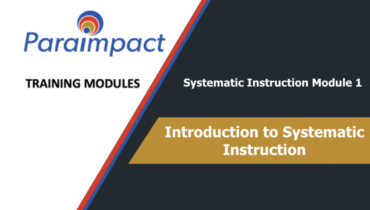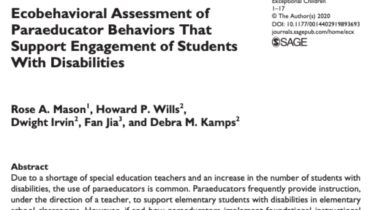In the website you will find the following information about the ParaImpact project:
- Complete project abstract
- Training modules
- Short biographies of each research team member
- Blog posts pertaining to the project
- Publications from the research team
- Contact info
We hope that the website content is informative and contributes to your knowledge of professional development to benefit special educators and paraeducators who serve elementary students with moderate to severe developmental disabilities!
This project is funded by the Institute of Education Sciences Award #R324A180186
About ParaImpact
Title of the Project: Para-Impact: Professional Development with Teacher-as-Coach for Paraeducators of Elementary Students with Moderate-to-Severe Developmental Disabilities
Purpose: The purpose of this project is to develop Para-Impact, a professional development (PD) package to train supervising teachers to utilize practice based coaching (PBC) to train their paras to implement systematic instruction for elementary students with moderate-to-severe developmental disabilities (MSDD). Para-Impact will include online instruction in PBC for teachers and also provide instructional resources including online training modules in systematic instruction, evaluation and performance feedback, and progress monitoring of paras performance. Students with MSDD have highly intensive and variable learning needs that require learning environments highly saturated with evidence-based practices (EBP). However, the educational workforce for special education is largely comprised of paraprofessionals, most with little to no formal training in education. Further, special education teachers have limited experience in supervising and training paras to deliver EBP. The development of Para-Impact will address this research-to-practice gap, providing a mechanism for teachers to supervise, train, and evaluate paras’ delivery of EBP for students with MSDD.
Topic and Goal: NCSER Professional Development for Teachers and Related Service Providers, Goal 2
Setting: Elementary schools in Indiana, Virginia, and Kansas in urban, suburban, and rural settings
Sample: Elementary (K-5) paraprofessionals (n= 22), teachers (n= 22), and school-level administrators (n=10) will participate in focus groups and usability testing. For the pilot study, teacher-para dyads (n= 50 each) and students with MSDD (n= 50-150) will participate.
Intervention: Para-Impact will be a PD package designed to train teachers to implement PBC as a mechanism to train, provide feedback, and monitor progress of paras’ delivery of systematic instruction to students with MSDD. Components will include online (1) content specific instruction for teachers and paras, and (2) PBC procedures using a Teacher-as-Coach model.
Research Design and Methods: In Year 1, we will use an iterative process to develop instructional modules, coaching materials, and training manuals including any applicable measures, tools, and procedures. In Year 2, usability testing with paras and teachers using single case designs will be used to further refine Para-Impact. In Year 3, researchers will conduct a randomized pilot study to determine the promise of Para-Impact for (1) improving teacher supervision and para practice and (2) increasing active engagement, academic responding, on-task behavior, and progress on individualized educational goals for students’ with MSDD.
Control Condition: An in-service on supervision (teachers) and systematic instruction (paras)
Key Measures: Measures used in Years 2 and 3 include percentage of coaching steps implemented correctly by teachers, percentage of steps for systematic instruction implemented correctly by paras, Classroom Team Survey (cohesion), frequency and duration data of para and child behavior utilizing MOOSES software, individualized Goal Attainment Scales; and researcher developed reviewer feedback forms, social validity, and fidelity measures.
Data Analytic Strategy: In Year 1 and 2 the research will use qualitative analysis and descriptive statistics to identify themes to guide development and revisions. In Year 2 descriptive statistics, as well as visual analysis and calculation of Tau-U effect size will be utilized to evaluate the impact of Para-Impact on increases in paras’ implementation fidelity of systematic instruction. Qualitative data analytic techniques will also guide revisions and refine Para-Impact. In Year 3, the researchers will conduct a randomized trial with repeated measures to examine main effects in the pilot study. A growth curve model within multilevel modeling (MLM) framework will be completed to analyze effects.













